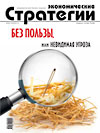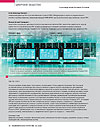Forming Organizational and Information Management Mechanisms Building a Digital Economy in Russia
Successful development of our country is closely connected with the option of creating a digital economy in Russia. Herewith, one of the most important components of this process is creation of supporting infrastructure for the digital economy as a convergent aggregate of digital ecosystems based on “big data” technologies, quantum computers, new production methods and artificial intelligence. Development of the Russian economy requires effective state regulation, increased manageability based on introduction of digital platforms for the main sectors of economy. The article dwells on formation of strategic mechanisms for monitoring, planning and market regulation of the Russian economy on the basis of building an integrated system of electronic markets for commodity resources using electronic trading platforms (ETP). Integrating ETP for creation of a complex system of electronic markets for commodity resources, associated with digital management platforms for major industries, creates new opportunities for optimizing dynamic interaction and adaptive improvement of commodity management transactions chains for creating a common logic of management processes in different commodity and market spaces and at all levels of management in Russia (and EAEU), which form the demand for issuing support of economic activity and volumes of financial resources (assets), denominated in a particular currency of one of the states — members of the EAEU.
References:
- Tsvetkov V.A. Prichiny, razvitie i posledstviya ekonomicheskogo krizisa dlya Rossii [Causes, Development and Consequences of the Economic Crisis for Russia]. Mezhdunarodnaya ekonomika, 2010, no 3, pp. 5–12.
- Perskaya V.V., Eskindarov M.A. Konkurentosposobnost’ natsional’nogo khozyaystva v usloviyakh mnogopolyarnosti: Rossiya, Indiya, Kitay [Competitiveness of the National Economy in the Multipolarity Conditions: Russia, India, China]. Moscow, Ekonomika, 2015, 219 p.
- Sokolov I.A., Drozhzhinov V.I., Raykov A.N., Kupriyanovskiy V.P., Namiot D.E., Cukhomlin V.A. Iskusstvennyy intellekt kak strategicheskiy instrument ekonomicheskogo razvitiya strany i sovershenstvovaniya ee gosudarstvennogo upravleniya. Chast’ 1. Opyt Velikobritanii i SShA [Artificial Intelligence as a Strategic Tool for Economic Development of the Country and Improvement of its Public Administration. Part 1. Experience of Great Britain and USA]. International Journal of Open Information Technologies, 2017, no 9, pp. 57–75.
- Sokolov I.A., Drozhzhinov V.I., Raykov A.N., Kupriyanovskiy V.P., Namiot D.E., Cukhomlin V.A. Iskusstvennyy intellekt kak strategicheskiy instrument ekonomicheskogo razvitiya strany i sovershenstvovaniya ee gosudarstvennogo upravleniya. Chast’ 2. Perspektivy primeneniya iskusstvennogo intellekta v Rossii dlya gosudarstvennogo upravleniya [Artificial Intelligence as a Strategic Tool for Economic Development of the Country and Improvement of its Public Administration. Part 2. Prospects of Applying Artificial Intelligence in Russia for Public Administration]. International Journal of Open Information Technologies, 2017, no 9, pp. 76–101.
- Ageev A.I., Loginov E.L. Gosplan — osnovnye organizatsionnye podkhody k formirovaniyu sistemnykh mekhanizmov monitoringa i planirovaniya rynochnogo sotsial’no-ekonomicheskogo razvitiya Rossii [Gosplan — Basic Approaches to Planning Socio-Economic Development of Russia]. Ekonomicheskie strategii, 2013, no 8, pp. 100–108.
- Ageev A.I., Kuroedov B.V., Met’yuz R., Sandarov O.V. Metodologiya strategicheskoy matritsy [Strategic Matrix Methodology]. Moscow, INES, 2004, 243 p.
- Bortalevich V.Yu., Loginova V.E. Korporativnoe upravlenie gruppami khozyaystvuyushchikh sub”ektov v ramkakh EAES. 25 let SNG: osnovnye itogi, problemy, perspektivy razvitiya: Materialy mezhdunarodnoy nauchno-prakticheskoy konferentsii [Corporate Governance of Economic Entities Groups Within the EAEU Framework // 25 Years of the CIS: Major Results, Problems, Development Prospects: Proceedings of the International Scientific-Practical Conference]. Pod redaktsiey chlena-korrespondenta RAN V.A. Tsvetkova. Moscow, IPR RAN, 2016, pp. 112–113.
- Aver’yanov M.A., Evtushenko S.N., Kochetova E.Yu. Tsifrovaya ekonomika. Transformatsiya otrasley [Digital Economy. Industries Transformation]. Ekonomicheskie strategii, 2016, no 8 (142), pp. 52–54.
- Koval’chuk Yu.A., Stepnov I.M. Tsifrovaya ekonomika: transformatsiya promyshlennykh predpriyatiy [Digital Economy: Transformation of Industrial Enterprises]. Innovatsii v menedzhmente, 2017, no 1 (11), pp. 32–43.
- Raykov A.N. Konvergentnoe upravlenie i podderzhka resheniy [Convergent Management and Solutions Support]. Moscow, IKAR, 2009, 244 p.
- Saraev V.N., Kobyakov A.A., Vayno A.E., Kobyakova N.G., Kozlov L.N., Podolyak V.I., Panfilov S.A., Loginov E.L. Global’naya tranzaktsionnaya sistema [Global Transaction System]. Patent na poleznuyu model’ RUS 98276 26.04.2010.
- Chernov V.A. Integrirovannoe informatsionno-analiticheskoe obespechenie i iskusstvennyy intellekt v sisteme upravleniya [Integrated Information-Analytical Support and Artificial Intelligence in Management System]. Audit, 2017, no 1, pp. 17–23.
- Kupriyanovskiy V.P., Utkin N.A., Namiot D.E., Kupriyanovskiy P.V. Tsifrovaya ekonomika = modeli dannykh + bol’shie dannye + arkhitektura + prilozheniya? [Digital Economy = Data Models + Big Data + Architecture + Applications?]. International Journal of Open Information Technologies, 2016, no 5, pp. 1–13.
- Andieva E.Yu., Fil’chakova V.D. Tsifrovaya ekonomika budushchego, industriya 4.0 [Digital Economy of the Future, Industry 4.0]. Prikladnaya matematika i fundamental’naya informatika, 2016. № 3. S. 214–218.
- Loginov E.L., Sorokin D.D. Forsayt tekhnologicheskogo razvitiya kak instrument podderzhki protsessov planirovaniya zakazov i postavok slozhnoy naukoemkoy produktsii v ramkakh kooperatsionnykh tsepochek EAES [Technological Development Foresight as a Support Tool for Planning of Orders and Deliveries of Complex Science-Intensive Products Within the Framework of EAEU Cooperation Chains]. Obrazovanie. Nauka. Nauchnye kadry, 2017, no 1, pp. 96–100.
- Kupriyanovskiy V.P., Sinyagov S.A., Klimov A.A., Petrov A.V., Namiot D.E. Tsifrovye tsepi postavok i tekhnologii na baze blokcheyn v sovmestnoy ekonomike [Digital Supply Chains and Technologies Based on Blockchain in a Joint Economy]. International Journal of Open Information Technologies, 2017, no 8, pp. 80–95.



